Vania Bogorny
TraClets: Harnessing the power of computer vision for trajectory classification
May 30, 2022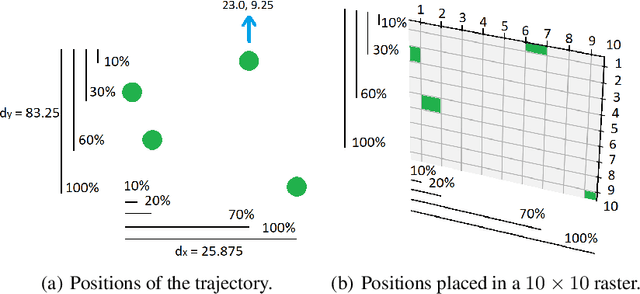
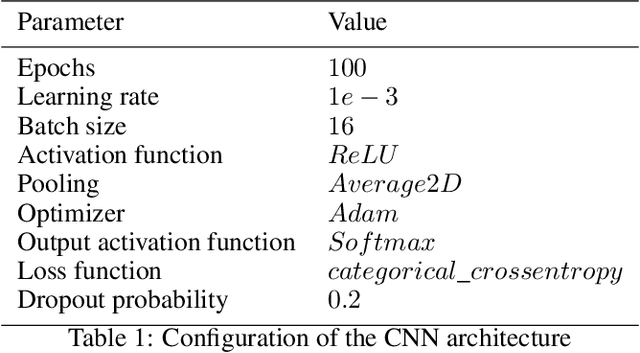
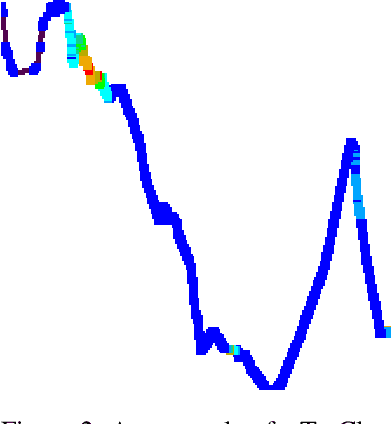

Abstract:Due to the advent of new mobile devices and tracking sensors in recent years, huge amounts of data are being produced every day. Therefore, novel methodologies need to emerge that dive through this vast sea of information and generate insights and meaningful information. To this end, researchers have developed several trajectory classification algorithms over the years that are able to annotate tracking data. Similarly, in this research, a novel methodology is presented that exploits image representations of trajectories, called TraClets, in order to classify trajectories in an intuitive humans way, through computer vision techniques. Several real-world datasets are used to evaluate the proposed approach and compare its classification performance to other state-of-the-art trajectory classification algorithms. Experimental results demonstrate that TraClets achieves a classification performance that is comparable to, or in most cases, better than the state-of-the-art, acting as a universal, high-accuracy approach for trajectory classification.
Mining frequency-based sequential trajectory co-clusters
Oct 27, 2021

Abstract:Co-clustering is a specific type of clustering that addresses the problem of finding groups of objects without necessarily considering all attributes. This technique has shown to have more consistent results in high-dimensional sparse data than traditional clustering. In trajectory co-clustering, the methods found in the literature have two main limitations: first, the space and time dimensions have to be constrained by user-defined thresholds; second, elements (trajectory points) are clustered ignoring the trajectory sequence, assuming that the points are independent among them. To address the limitations above, we propose a new trajectory co-clustering method for mining semantic trajectory co-clusters. It simultaneously clusters the trajectories and their elements taking into account the order in which they appear. This new method uses the element frequency to identify candidate co-clusters. Besides, it uses an objective cost function that automatically drives the co-clustering process, avoiding the need for constraining dimensions. We evaluate the proposed approach using real-world a publicly available dataset. The experimental results show that our proposal finds frequent and meaningful contiguous sequences revealing mobility patterns, thereby the most relevant elements.
PTRAIL -- A python package for parallel trajectory data preprocessing
Aug 26, 2021
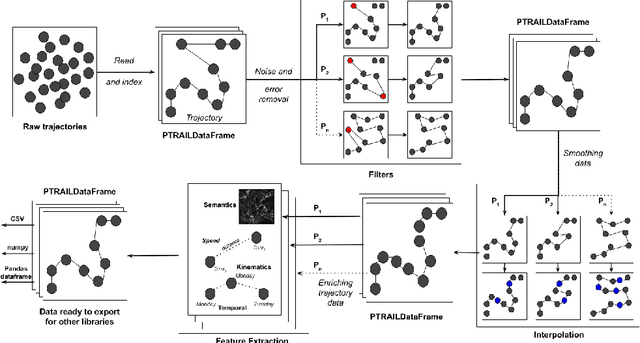

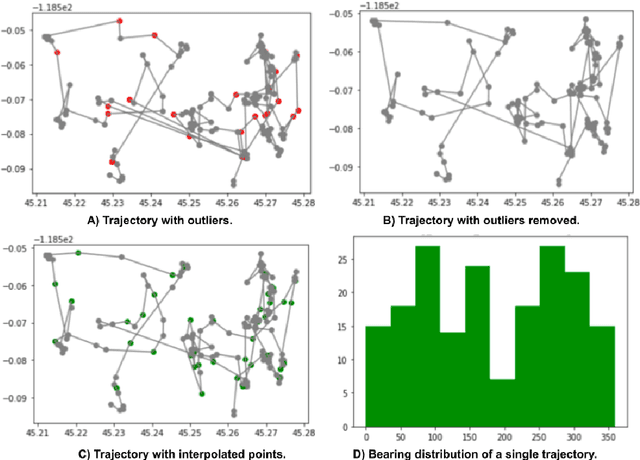
Abstract:Trajectory data represent a trace of an object that changes its position in space over time. This kind of data is complex to handle and analyze, since it is generally produced in huge quantities, often prone to errors generated by the geolocation device, human mishandling, or area coverage limitation. Therefore, there is a need for software specifically tailored to preprocess trajectory data. In this work we propose PTRAIL, a python package offering several trajectory preprocessing steps, including filtering, feature extraction, and interpolation. PTRAIL uses parallel computation and vectorization, being suitable for large datasets and fast compared to other python libraries.
Fast discovery of multidimensional subsequences for robust trajectory classification
Feb 09, 2021

Abstract:Trajectory classification tasks became more complex as large volumes of mobility data are being generated every day and enriched with new sources of information, such as social networks and IoT sensors. Fast classification algorithms are essential for discovering knowledge in trajectory data for real applications. In this work we propose a method for fast discovery of subtrajectories with the reduction of the search space and the optimization of the MASTERMovelets method, which has proven to be effective for discovering interpretable patterns in classification problems.
Challenges in Vessel Behavior and Anomaly Detection: From Classical Machine Learning to Deep Learning
Apr 07, 2020



Abstract:The global expansion of maritime activities and the development of the Automatic Identification System (AIS) have driven the advances in maritime monitoring systems in the last decade. Monitoring vessel behavior is fundamental to safeguard maritime operations, protecting other vessels sailing the ocean and the marine fauna and flora. Given the enormous volume of vessel data continually being generated, real-time analysis of vessel behaviors is only possible because of decision support systems provided with event and anomaly detection methods. However, current works on vessel event detection are ad-hoc methods able to handle only a single or a few predefined types of vessel behavior. Most of the existing approaches do not learn from the data and require the definition of queries and rules for describing each behavior. In this paper, we discuss challenges and opportunities in classical machine learning and deep learning for vessel event and anomaly detection. We hope to motivate the research of novel methods and tools, since addressing these challenges is an essential step towards actual intelligent maritime monitoring systems.
Wise Sliding Window Segmentation: A classification-aided approach for trajectory segmentation
Mar 23, 2020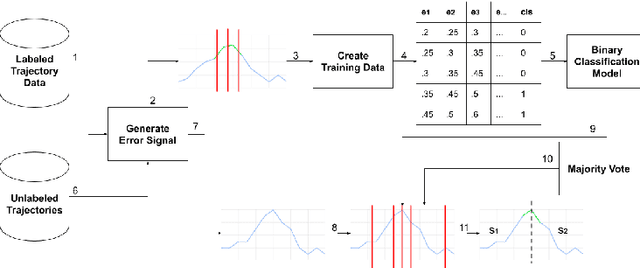

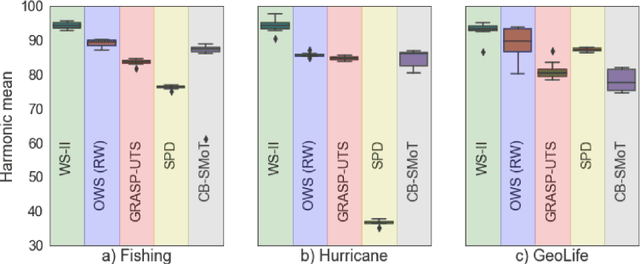
Abstract:Large amounts of mobility data are being generated from many different sources, and several data mining methods have been proposed for this data. One of the most critical steps for trajectory data mining is segmentation. This task can be seen as a pre-processing step in which a trajectory is divided into several meaningful consecutive sub-sequences. This process is necessary because trajectory patterns may not hold in the entire trajectory but on trajectory parts. In this work, we propose a supervised trajectory segmentation algorithm, called Wise Sliding Window Segmentation (WS-II). It processes the trajectory coordinates to find behavioral changes in space and time, generating an error signal that is further used to train a binary classifier for segmenting trajectory data. This algorithm is flexible and can be used in different domains. We evaluate our method over three real datasets from different domains (meteorology, fishing, and individuals movements), and compare it with four other trajectory segmentation algorithms: OWS, GRASP-UTS, CB-SMoT, and SPD. We observed that the proposed algorithm achieves the highest performance for all datasets with statistically significant differences in terms of the harmonic mean of purity and coverage.
Unsupervised Behavior Change Detection in Multidimensional Data Streams for Maritime Traffic Monitoring
Aug 14, 2019
Abstract:The worldwide growth of maritime traffic and the development of the Automatic Identification System (AIS) has led to advances in monitoring systems for preventing vessel accidents and detecting illegal activities. In this work, we describe research gaps and challenges in machine learning for vessel behavior change and event detection, considering several constraints imposed by real-time data streams and the maritime monitoring domain. As a starting point, we investigate how unsupervised and semi-supervised change detection methods may be employed for identifying shifts in vessel behavior, aiming to detect and label unusual events.
Discovering Heterogeneous Subsequences for Trajectory Classification
Mar 18, 2019



Abstract:In this paper we propose a new parameter-free method for trajectory classification which finds the best trajectory partition and dimension combination for robust trajectory classification. Preliminary experiments show that our approach is very promising.
Discovering Semantic Spatial and Spatio-Temporal Outliers from Moving Object Trajectories
Mar 21, 2013



Abstract:Several algorithms have been proposed for discovering patterns from trajectories of moving objects, but only a few have concentrated on outlier detection. Existing approaches, in general, discover spatial outliers, and do not provide any further analysis of the patterns. In this paper we introduce semantic spatial and spatio-temporal outliers and propose a new algorithm for trajectory outlier detection. Semantic outliers are computed between regions of interest, where objects have similar movement intention, and there exist standard paths which connect the regions. We show with experiments on real data that the method finds semantic outliers from trajectory data that are not discovered by similar approaches.
 Add to Chrome
Add to Chrome Add to Firefox
Add to Firefox Add to Edge
Add to Edge